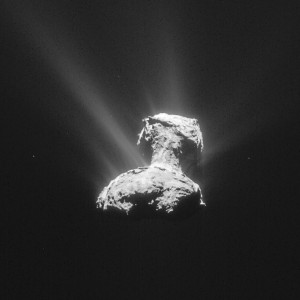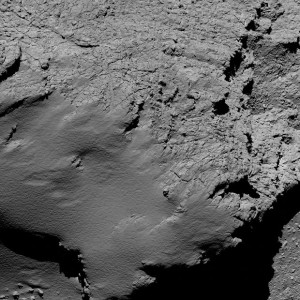Peter Lobner
The European Space Agency (ESA) launched the Rosetta mission in 2004. After its long journey from Earth, followed by 786 days in orbit around comet 67P / Churyumov–Gerasimenko, the Rosetta spacecraft managers maneuvered the spacecraft out of its orbit and directed it to a “hard” landing on the “head” (the smaller lobe) of the comet.
 Comet 67P. Source: ESA – European Space Agency
Comet 67P. Source: ESA – European Space Agency
The descent path, which started from an altitude of 19 km (11.8 miles), was designed to bring Rosetta down in the vicinity of active pits that had been observed from higher altitude earlier in the mission. ESA noted:
- The descent gave Rosetta the opportunity to study the comet’s gas, dust and plasma environment very close to its surface, as well as take very high-resolution images.
- Pits are of particular interest because they play an important role in the comet’s activity (i.e., venting gases to space).
The spacecraft impacted at a speed of about 90 cm/sec (about 2 mph) at 11:19 AM GMT (4:19 AM PDT) on 30 September 2016. I stayed up in California to watch the ESA’s live stream of the end of this important mission. I have to say that the live stream was not designed as a media event. As the landing approached, only a few close-up photos of the surface were shown, including the following photo taken from an altitude of about 5.7 km (3.5 miles).
 Source: ESA – European Space Agency
Source: ESA – European Space Agency
At the appointed moment, touchdown was marked by the loss of the telemetry signal from Rosetta. ESA said that the Rosetta spacecraft contained a message in many languages for some future visitor to 67P to find.
You can read the ESA’s press release on the end of the Rosetta mission at the following link:
Some of the key Rosetta mission findings reported by ESA include:
- Comet 67P likely was “born” in a very cold region of the protoplanetary nebula when the Solar System was still forming more than 4.5 billion years ago.
- The comet’s two lobes probably formed independently, joining in a low-speed collision in the early days of the Solar System.
- The comet’s shape influences its “seasons,” which are characterized by variations in dust moving across its surface and variations in the density and composition of the coma, the comet’s ‘atmosphere’.
- Gases streaming from the comet’s nucleus include molecular oxygen and nitrogen, and water with a different ‘flavor’ than water in Earth’s oceans.
- 67P’s water contains about three times more deuterium (a heavy form of hydrogen) than water on Earth.
- This suggests that comets like Rosetta’s may not have delivered as much of Earth’s water as previously believed.
- Numerous inorganic chemicals and organic compounds were detected by Rosetta (from orbit) and the Philae lander (on the surface). These include the amino acid glycine, which is commonly found in proteins, and phosphorus, a key component of DNA and cell membranes.
Analysis of data from the Rosetta mission will continue for several years. It will be interesting to see how our understanding of comet 67P and similar comets evolve in the years ahead.
For more information on the Rosetta mission, visit the ESA’s Rosetta website at the following link:
Also see my following postings: 24 August 2016, “Exploring Microgravity Worlds,” and 6 September 2016, “Philae Found in a Rocky Ditch on Comet 67P/Churyumov-Gerasimenko.”